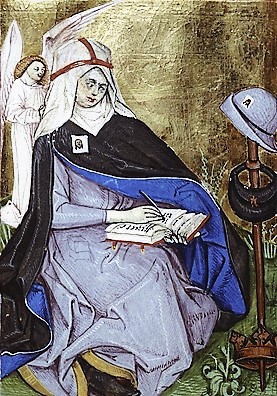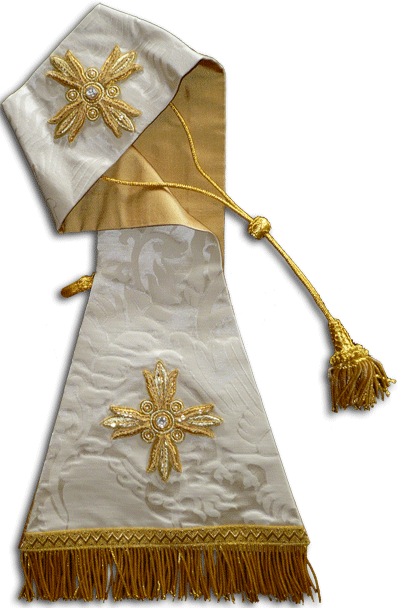Text and Illustrations from Wikipedia - the free encyclopaedia,
unless otherwise stated.

Strasbourg Cathedral,
Alsace, France.
Photo: 8 February 2014.
Source: Own work.
Author: Diliff.
"Photo by DAVID ILIFF.
License: CC-BY-SA 3.0"
(Wikimedia Commons)

The Nave,
Strasbourg Cathedral,
Alsace, France.
Photo: 8 February 2014.
Source: Own work.
Author: Diliff.
"Photo by DAVID ILIFF.
License: CC-BY-SA 3.0"
(Wikimedia Commons)
Although considerable parts of it are still Romanesque architecture, it is widely considered to be among the finest examples of High-, or Late-, Gothic architecture. Erwin von Steinbach is credited for major contributions from 1277 to his death in 1318.
At 142 metres (466 feet) high, it was the World's tallest building from 1647 to 1874 (227 years), when it was surpassed by Saint. Nikolai's Church, Hamburg, Germany. Today, it is the sixth-tallest Church in the World and the highest still-standing structure built entirely in The Middle Ages.

English: Statues on the Right of The Great West Door, Strasbourg Cathedral.
Français: Statues de l'ébrasement droit de la porte centrale du portail occidental
de la cathédrale de Strasbourg.
Photo: 27 December 2008.
Source: Own work.
Author: Coyau.
Attribution: Coyau / Wikimedia Commons / CC-BY-SA-3.0.
(Wikimedia Commons)
The site of Strasbourg Cathedral was used for several successive Religious buildings, starting from the Argentoratum period (when a Roman Sanctuary occupied the site) up to the building that is there today.
It is known that a Cathedral was erected by Bishop Saint Arbogast, of the Strasbourg Diocese, at the end of the 7th-Century A.D., on the base of a temple Dedicated to The Virgin Mary, but nothing remains of it today. Strasbourg's previous Cathedral, remains of which, dating back to the Late-4th-Century or Early-5th-Century, were unearthed in 1948 and 1956, was situated at the site of the current Église Saint-Étienne.

English: West façade of the Cathedral Notre-Dame de Strasbourg.
Français: Façade ouest de la cathédrale Notre-Dame de Strasbourg.
Photo: 20 August 2005.
Source: Own work.
Author: Neuceu.
(Wikimedia Commons)

English: Chandelier and Stained-Glass Windows,
Our Lady of Strasbourg Cathedral,
Strasbourg, France.
Français: Chandelier du collatéral sud,
Notre Dame, Strasbourg, France.
Photo: 8 March 2011.
Source: notre dame (7)
Author: Anca Pandrea from Bucharest, Romania.
(Wikimedia Commons)
After that disaster, Bishop Heinrich von Hasenburg decided to construct a new Cathedral, to be more beautiful than that of Basel, which was just being finished. Construction of the new Cathedral began on the Foundations of the preceding structure, and did not end until Centuries later. Werner's Cathedral's Crypt, which had not burned, was kept, and expanded Westwards.

Flying Buttresses on the South Side
of Strasbourg Cathedral.
Photo: September 2007.
Source: Own work.
Author: Jonathan M.
(Wikimedia Commons)
The parts of the Nave that had already been begun, in Romanesque Style, were torn down and, in order to find money to finish the Nave, the Chapter resorted to Indulgences in 1253. The money was kept by the Œuvre Notre-Dame (Editor: The Strasbourg Museum), which also hired architects and Stone-Workers. The influence of the Chartres Masters was also felt in the sculptures and statues; the "Pillar of Angels" (Pilier des anges), a representation of The Last Judgment on a Pillar in the Southern Transept, facing the Astronomical Clock, owes to their expressive style.
Like the City of Strasbourg, the Cathedral connects German and French cultural influences, while the Eastern structures, e.g. The Choir and South Portal, still have very Romanesque features, with more emphasis placed on walls than on windows.

English: "The Marriage Feast at Cana" Tapestry in the Nave of Strasbourg Cathedral.
Français: Tapisserie "Les noces de Cana" dans la nef de la cathédrale de Strasbourg.
Photo: 5 December 2009.
Source: Own work.
Author: Tangopaso.
(Wikimedia Commons)
Strasbourg Cathedral and Cologne Cathedral together represent some of the earliest uses of architectural drawing. The work of Professor Robert O. Bork, of the University of Iowa, suggests that the design of the Strasbourg façade, while seeming almost random in its complexity, can be constructed using a series of rotated octagons.
The North Tower, completed in 1439, was the world's tallest building from 1647 (when the Spire of Saint Mary's Church, Stralsund, Germany, burnt down) until 1874, (when the Tower of Saint Nikolai's Church in Hamburg, Germany, was completed). The planned South Tower was never built and, as a result, with its characteristic asymmetrical form, Strasbourg Cathedral is now the premier landmark of Alsace. One can see thirty kilometers from the Observation Level, which provides a view of the Rhine Banks, from the Vosges all the way to The Black Forest. The Octagonal Tower is the combined work of architects Ulrich Ensingen (Shaft) and Johannes Hültz of Cologne (top). Ensingen worked on the Cathedral from 1399 to 1419, and Hültz from 1419 to 1439.

Strasbourg Cathedral's
Astronomical Clock.
Photo: 8 February 2014.
Source: Own work.
Author: Diliff.
"Photo by DAVID ILIFF.
License: CC-BY-SA 3.0"
(Wikimedia Commons)
In the Late Middle Ages, the City of Strasbourg had managed to liberate itself from the domination of the Bishop and to rise to the status of Free Imperial City. The outgoing 15th-Century was marked by the Sermons of Johann Geiler von Kaisersberg and by the emerging Protestant Reformation, represented in Strasbourg by figures such as John Calvin, Martin Bucer and Jacob Sturm von Sturmeck.
In 1524, the City Council assigned the Cathedral to the Protestant faith, while the building suffered some damage from iconoclastic assaults. In 1539, the world's first documented Christmas Tree was set up inside the Münster. After the annexation of the City by Louis XIV of France, on 30 September 1681, and a Mass celebrated in the Cathedral on 23 October 1681 in the presence of the King and Prince-Bishop, Franz Egon of Fürstenberg, the Cathedral was returned to the Catholics and its inside re-designed according to The Catholic Liturgy of The Counter-Reformation.

The Cathedral of Notre Dame, Strasbourg,
turned into a "Temple of Reason"
during the French Revolution.
This File: 23 January 2006.
User: Tablar.
(Wikimedia Commons)
A round, Baroque Sacristy, of modest proportions, was added North-East of the Northern Transept, in 1744, by the City's Chief Architect, Joseph Massol, according to Plans by Robert de Cotte. Between 1772 and 1778, architect Jean-Laurent Goetz surrounded the Cathedral with a Gallery, in Early-Gothic-Revival Syle, in order to re-organise the merchants' shops that used to settle around the building (and would do so until 1843).
In April 1794, the Enragés, who ruled the City, started planning to tear the Spire down, on the grounds that it hurt the principle of equality. The Tower was saved, however, when, in May of the same year, citizens of Strasbourg crowned it with a giant tin Phrygian Cap, of the kind the Enragés themselves wore. This artifact was later kept in the historical collections of the City, until they were all destroyed in a massive fire in August 1870.

Engraving depicting the inside of
Strasbourg Cathedral in 1617.
Published by Isaak Brun.
Source: http://www.metmuseum.org/Collections/search-the-collections/
90023273?rpp=60&pg=1&gallerynos=690&ft=*&pos=57
(Wikimedia Commons)
During World War II, Strasbourg's Cathedral was seen as a symbol for both warring parties. Adolf Hitler, who visited it on 28 June 1940, intended to transform the Church into a "National Sanctuary of the German People" or into a Monument to The Unknown Soldier, on 1 March 1941, General Leclerc, of France, made the "Vow of Kufra" (Serment de Koufra), stating he would "rest the weapons only when our beautiful Colours fly again on Strasbourg's Cathedral". During that same war, the Stained-Glass was removed, in seventy-four Cases, from the Cathedral and stored in a Salt Mine, near Heilbronn, Germany. After the war, it was returned to the Cathedral by the Monuments, Fine Arts and Archives Section of the United States Military.

English: The Tempter courting The Foolish Virgins
(sculpture in the South Aisle Portal of the West Façade).
Français: Strasbourg, portail sud de la cathédrale. Le tentateur (il tient la pomme
de la tentation, son dos est dévoré par des crapauds et des reptiles) et les vierges
folles (elles tiennent les lampes retournées, serrent fermées les tables de la loi).
Photo: 12 November 2010.
Source: Own work.
Author: Coyau.
Attribution: Coyau / Wikimedia Commons / CC-BY-SA-3.0.
(Wikimedia Commons)
In October 1988, when the City was commemorating 2,000 years of the Founding of Argentoratum, Pope Saint John Paul II visited and Celebrated Mass in the Cathedral. This event was also an occasion to celebrate the Franco-Germany Reconciliation.
In 2000, an Al-Qaeda plot to bomb the adjacent Christmas Market was prevented by French and German Police.

Deutsch: Bild aufgenommen in Straßburg.
Rosenfenster im Straßburger Münster.
English: Picture taken in Strasbourg Cathedral.
The Rose Window, Notre-Dame de Strasbourg.
Photo: 20 December 2010.
Source: Own work.
Author: DerHexer, Wikimedia Commons.
Attribution: “DerHexer, Wikimedia Commons, CC-by-sa 4.0”.
(Wikimedia Commons)
Strasbourg Cathedral's Rose Window
and the Organ.
Photo: 22 December 2011.
Source: Cathédrale Notre-Dame.
Author: Alexandre Prévot from Nancy, France.
(Wikimedia Commons)


















+(from+In+Caelo+et+in+Terra+Blog).jpg)




